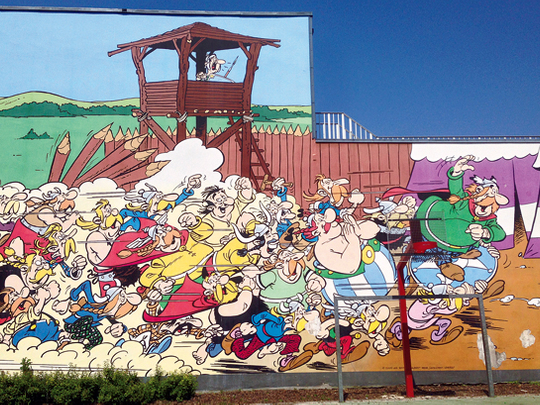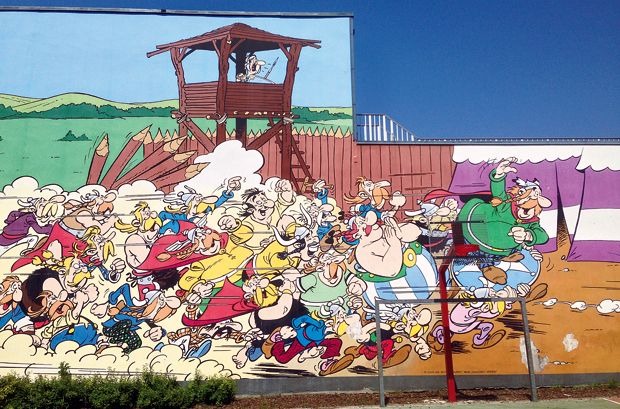
Call it the 300 and Sin City effect, but over the past few years, comics are firmly back in vogue. Oh sorry, I mean graphic novels... comics are for kids, right? Wrong, sir, very wrong. The joys of illustrated stories do not submit to such trivialities as age or, for that matter, nomenclature. Take it from someone who read his first Adventures of Tintin comic when he was about two feet tall.
Spellbound, I went on to read the rest of the legendary Belgian artist Hergé’s comic masterpieces as a child, then again as a teenager, and once more in adulthood. Heck, I re-read The Broken Ear just a couple of months ago and still found myself chuckling at fresh subtleties.
For Tintin fans who have travelled to various exotic countries, from Tibet and Peru to the Wild West and the Red Sea – even into space! – in the pages of Hergé’s books, a visit to the author’s homeland is the final adventure. But landing in the Belgian capital will quickly reveal that the iconic boy reporter and his dog are only the tip of the illustrated iceberg.
Most world cities put up statues of historical heroes at their airports and town squares. Not Brussels. This delightfully tongue-in-cheek city of a million people is adorned with depictions of its scribbled sons – Tintin, Lucky Luke, the Smurfs, all world-renowned Belgian creations.
For what is a relatively tiny country, Belgium’s influence in the world of comics is immense, rivalled only by the United States and Japan. Franco-Belgian comics – known as BDs, bandes dessinées or the drawn strip – have a long history. They are considered the ninth art and taken no less seriously than sculpture, poetry or film.
Quickly evolving from a few panels in newspapers at the start of the 20th century, BDs began to appear as entire albums in the 1920s – if rather unrefined, as with 1929’s Tintin in the Land of the Soviets. But it was after the Second World War – during which BDs emerged as a great way to not only escape for a few hours, but also to subtly combat and mock the censorship imposed by the Nazis – that they really took off, becoming household names over the next three decades.
In the 1990s, Brussels city authorities began adorning selected buildings with large murals depicting the most famous Belgian comic characters, set within Brusselian scenes. Under the stewardship of the Art Mural collective, the city’s larger-than-life collection of public wall art has expanded to more than 50 murals.
Naturally, one of the best ways to explore Brussels is to join the mural dots – soaking up culinary and architectural delights along the way. You don’t have to be a comic buff to do the Comic Strip Walk; there are guided walking and bicycle tours, and city-supplied route maps, to turn you into one.
You could start with a visit to the Belgian Comic Strip Centre (www.comicscenter.net). Housed in a Victor Horta-designed art nouveau building on Rue des Sables, it’s full of fascinating exhibits on the history of BD, the different styles and phases of development, and how they’re created – all conveyed in the BD medium, natch.
Its Museum of Imagination exhibit covers the biographies and careers of the best-known Belgian artists, with displays of their artefacts. Pride of place in the Centre is of course given to Tintin, through some wonderful charts, posters, figurines and even a three-metre-tall model of the famous red-and-white checkered Moon rocket.
A stone’s throw from the Centre is a statue of Gaston, André Franquin’s much-loved, gaffe-prone character, and hero of the famed weekly magazine Spirou. Gaston – hugely popular for his endearing, free-spirited and subversive messages – also gets his own mural over on Rue de l’Écuyer, dropping a yo-yo on to a passerby from a third-floor window.
This clever incorporation of a BD character’s well-known traits with the elements and structure of the building he or she features on is typical of Brussels’ murals. You can see it in the design of Passe-Moi L’ciel, which arranges Stuf’s cherubic St Peter and a frustrated devil trying to barbecue chicken across four storeys of a building on Rue de Minimes; or at Rue des Capucins, where Hergé’s naughty boys Quick and Flupke hide from a policeman around the corner of a wall; and in a schoolyard on the same street, where a horde of indomitable Gauls surge across a wall, in tribute to the French creators of the Tintin-rivalling Asterix series – Goscinny and Uderzo, who first worked together for a Belgian company.
Mural after mural reveals the variety and prolific output of Belgian artists, with vivid styles creating wonderful changes of mood as you walk the route. Many murals (such as Broussaille, Le Jeune Albert, and Boule et Bill) depict beautiful vistas of Brussels in another age, with lovingly rendered trams and cars, bowler hats and suits, monuments, waterfronts and coffee houses.
Is Kate the new Diana?
6 Stunt-tastic facts about the new spidey flick
Get selfie ready
Michael Fassbender finds his sweet spot in Hollywood
Addressing a shocking problem
Juicing: food fad or health saviour?
Suresh Menon: A gaggle of Google gems
Vinod Thakur: I’m living a dream life
Kalki Koechlin on finding her niche in Bollywood
Others bring a touch of the magical to our urban existence. Mystic winged female angels, aliens, fireworks, cats, kids, scouts, spies, detectives, pirates, cowboys – all lie in wait for you to turn a corner just so they can brighten your day with their oversized antics and wide-angle dreamscapes. This is the power of comics made real – interacting with the everyday; reminding you always that there is more to life than the daily routine; that to escape, you just have to take a moment and look with new eyes.
At the corner of Rue de l’Étuve, the eternal crowd of tourists around the famed Manneken Pis statue makes you wonder what the fuss is all about – he’s tiny! – though his ever-changing variety of joke costumes does elicit a chuckle. However, his presence marks a nearby mural of importance – possibly the only Belgian boy more famous than him: Tintin, descending a flight of stairs along with his little white dog Snowy and amusingly bad-tempered sidekick Captain Haddock.
Icon that he is, Manneken is also referenced in two other Walk murals: one on Rue de Flandre, where the cheery dog Cubitus takes on his role with typical canine enthusiasm; another on Rue de Laeken, where the little man is depicted balancing a human tower of characters including Willy Vandersteen’s adventurous adolescents Bob and Bobette (Spike and Suzy in the English world), all while maintaining his legendary flow.
Further leisurely perambulation brings you to the Grand Place, a spectacular, vast, central square surrounded by ornate guildhalls and lorded over by the 96-metre-tall tower of the town hall.
Bombarded in war, ransacked by revolutionaries and left to ruin over the centuries, Grand Place was restored in the 19th century and is now a Unesco World Heritage site full of bustling commerce and tourist action.
Sitting in the sunshine, recharging your batteries with a large tray of generously topped waffles, you can only ponder: how good would a Tintin adventure set in Belgium have been? Well, now you know.







